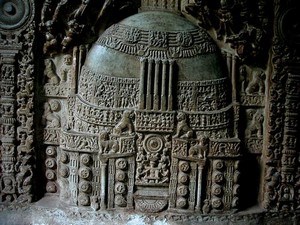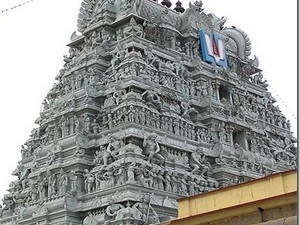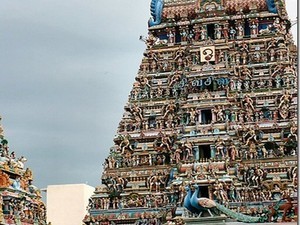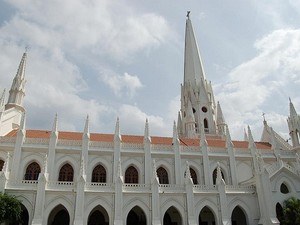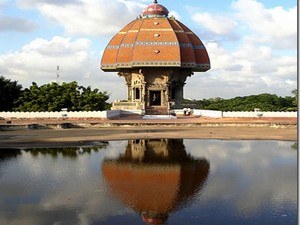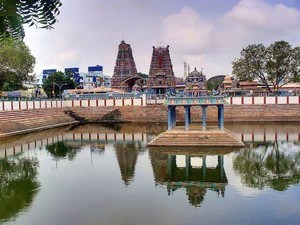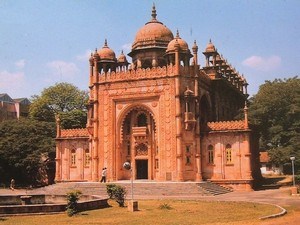Kapiliswarar Temple, Chennai - Timings, Festivals, History, Darshan, Pooja Timings
Photo Credit: Flickr
 #4 of 37 Places to Visit in Chennai
#4 of 37 Places to Visit in Chennai
 Distance (From Chennai Central Railway Station): 6.5 Kms
Distance (From Chennai Central Railway Station): 6.5 Kms
 Trip Duration (Including Travel): 1 Hour
Trip Duration (Including Travel): 1 Hour
 Place Location: In Mylapore
Place Location: In Mylapore
 Transportation Options: Bus / Cab / Auto
Transportation Options: Bus / Cab / Auto
 Travel Tips: None
Travel Tips: None
About Kapaleeswarar Temple
At a distance of 6 Km from Chennai Central Railway Station, the Kapaleeswarar Temple is a Hindu temple located in the Mylapore locality of Chennai. This is one of the top places to visit in Chennai. The Kapaleeswarar Temple is dedicated to Lord. The presiding deity is revered in the 7th-century Tamil Shaiva canonical work, the Tevaram, written by Tamil saint poets known as the Nayanars and classified as one of the Paadal Petra Sthalams of Lord Shiva.
History of Kapaleeswarar Temple
The Kapaleeswarar Temple in Mylapore is believed to have been built by the Pallavas in the 7th century CE, as indicated by hymns from Nayanar saints and inscriptions from the 12th century. The original temple was destroyed by the Portuguese, and the current structure is rebuilt by the Vijayanagara rulers in 16th century. The temple's 120 feet gopuram was built during 1906 with stucco figures adorning it. The temple is maintained and administered by the Hindu Religious and Endowment Board of the Government of Tamil Nadu.
Mythology of Kapaleeswarar Temple
According to the Puranas, Parvati worshipped Lord Shiva in the guise of a peahen (referred to as 'mayil' in Tamil) in an effort to regain her original form by earning Shiva's favor, which led to the naming of the area surrounding the temple as Mylai. Additionally, Goddess Parvati bestowed upon her second son, Lord Murugan, his renowned spear, known as 'Vel,' to vanquish a formidable demon. It is also said that Shukra worshipped at this location to recover his lost eye, which had been damaged by Vamana, an incarnation of Lord Vishnu, using a blade of dharba grass. At this site, Thirugyana Sambandhar miraculously saved and revived the daughter of Sivanesa Chettiar Angam Poompavai, who had succumbed to a snake bite. Furthermore, a Nayanar saint named Vayilar achieved moksha, or liberation, at this sacred place.
In another tale, Lord Brahma visited Lord Shiva atop Mount Kailash but failed to show him the proper respect. In response, Shiva removed one of Brahma's five heads (known as 'kapala'). To atone for his actions, Lord Brahma came to the location in Mylapore, where the temple now stands, and installed a Shiva Linga to appease Shiva, seeking to rid himself of his ego and regain his creative powers. The term 'kapala' in Sanskrit translates to skull, which is why Lord Shiva is revered as Kapaleeswarar, and the place of worship is referred to as Kapaleeswaram.
Architecture of Kapaleeswarar Temple
The Kapaleeswarar Temple exemplifies the traditional Dravidian architectural style, featuring pyramid-shaped towers, pillared halls, and enclosed courtyards. It has two entrances, each marked by a gopuram. The eastern gopuram rises to approximately 40 meters, while the smaller western gopuram overlooks the sacred tank which is located outside the main complex, and is believed to be the place where Parvati worshipped Shiva in the form of a peacock.
The main shrine is a square structure topped with a flat roof, housing a black granite lingam representing Lord Kapaleeswarar. His consort, Karpagambal, depicted as a form of Parvati holding a lotus, embodies grace and compassion. The name Karpagambal translates to 'the goddess of the wish-fulfilling tree,' referencing the legend in which Parvati grants a boon to a devotee afflicted with leprosy. Additionally, there are separate shrines dedicated to Lord Murugan, Lord Ganesha, and the Nayanars.
The temple complex includes several mandapams, such as the flagstaff hall and the 100-pillared hall, which hosts cultural events. The peacock hall illustrates the legend of Parvati worshipping Shiva in the guise of a peacock. These mandapams are adorned with exquisite and intricate sculptures depicting deities, saints, and mythical beings.
Festivals of Kapaleeswarar Temple
The Arulmigu Kapaleeswarar Temple in Mylapore, Chennai, hosts several festivals. The 10-day Panguni Brahmotsavam in March/April, the Arupathimoovar festival, and the Mylapore Festival in January and Maha Shivaratri in February/March are some of the most prominent festivals celebrated at Kapaleeswarar Temple.
Kapaleeswarar Temple Dress Code & Other Restrictions
When planning a visit to Kapaleeswarar Temple, it is recommended to adhere to modest clothing that covers your upper arms and legs as a sign of respect. Men are encouraged to wear a dhoti or pajama paired with an upper garment, as well as formal trousers and shirts while women should wear a sari or chudidar with a top covering. It is advisable to refrain from wearing contemporary attire such as mini-skirts, jeans, shorts, and sleeveless tops while on the temple grounds.
Non-Hindus are welcome to explore the temple complex and appreciate its architectural beauty; however, access to the sanctum sanctorum may be restricted.
Kapaleeswarar Temple Timings
Monday: 5 AM - 12 PM & 4 PM - 9:30 PM
Tuesday: 5 AM - 12 PM & 4 PM - 9:30 PM
Wednesday: 5 AM - 12 PM & 4 PM - 9:30 PM
Thursday: 5 AM - 12 PM & 4 PM - 9:30 PM
Friday: 5 AM - 12 PM & 4 PM - 9:30 PM
Saturday: 5 AM - 12 PM & 4 PM - 9:30 PM
Sunday: 5 AM - 12 PM & 4 PM - 9:30 PM
Kapaleeswarar Temple Entry Fee
Entry is Free
Best Time to Visit Kapaleeswarar Temple
The ideal period to explore Sri Kapaleeswarar Temple is between October and March, with the highest influx of visitors occurring from November to February. The 10-day Panguni Brahmotsavam in March/April, the Arupathimoovar festival, and the Mylapore Festival in January presents a unique chance to experience the vibrant atmosphere of the temple, attracting thousands of worshippers. It is recommended to refrain from visiting during the peak summer months of April to June, as the soaring temperatures can make outdoor activities challenging.
How to Reach Kapaleeswarar Temple
Situated almost 17 Km away, Chennai International Airport is the nearest airport to Kapaleeswarar Temple. From there, one can take a private cab or bus to reach the temple. Mylapore Thirumylai Railway Station is connected by the Metro railway network. Visitors can also access the temple via local buses, taxi or auto-rickshaw from any part of Chennai.





